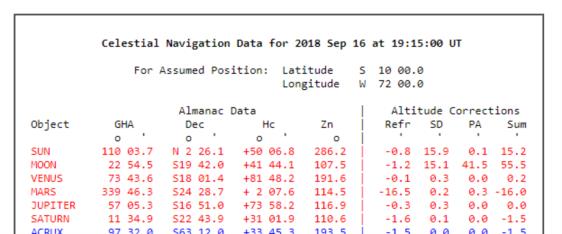
NavList:
A Community Devoted to the Preservation and Practice of Celestial Navigation and Other Methods of Traditional Wayfinding
From: Frank Reed
Date: 2018 Sep 20, 10:24 -0700
Antoine, you wrote:
"I have been surprised that - for height corrections purposes - the USNO indicates that they consider Planets as having an apparent semi-diameter and that "for the solar system bodies" (hence including all the planets as can be checked from the published Height Corrections "Sums") it considers that the Planet lower limb is assumed to have been observed. Hence it performs a systematic semi-diameter correction for the planets themselves. In addition to this quite strange procedure - as I habe been trained to use Planet SD = 0 - the USNO also specifies that the Venus phase effect correction is ignored."
First, I have always considered the altitude corrections in that resource to be merely illustrative --examples of the process-- not definitive. I agree with you that including planet semi-diameters is a weird, misleading, and distracting choice. I can imagine the software developer (probably over twenty years ago) looking at the data layout for this (text-based!) page and thinking about having an entire column for semi-diameters with only entries for the Sun and Moon... "Hey, wouldn't it be clever of me to include the semi-diameters of the planets?!"... And so it goes. The normal, standard procedure for dealing with the planets' finite size is to split them on the horizon, which is right at the limit of observability, or to split them on the limb of the Moon when shooting lunars, which is definitely observable with a 7x or better scope and was also the historical recommendation.
As for the Venus phase correction, I consider this an either/or proposition. When you shoot Venus with high magnification, you can see the tiny crescent if you know in advance that it's there (if you have looked up its phase, or thought it through from the geometry, or observed it recently with a small telescope) and you can then still shoot Venus "split" on the horizon, with its center on the horizon. Or if you shoot Venus with low magnification or without magnification, then you would prefer to use the "center of light", but of course at low magnification it's not clear that it would make any difference since 0.5' is below the limit of the resolution of the unaided human vision system --below the limit of "naked eye" observation. If you want to do "center of light" positions for Venus, it's not especially hard. There's an offset that depends on the phase angle, which I posted about some years ago, and you simply move in the direction of the Sun from the center of Venus by that small angular displacement.
When I look at the USNO data pages that you're referring to, I always divide them at the vertical line (composed of text "pipe" characters... | ). The data to the left of that dividing line is rock-solid. You can trust the GHA, Dec, Hc, Zn values. The data to the right for altitude corrections is something that I see as "sample data". Clearly you can't count it as definitive for height corrections since they don't provide any option for height of eye to calculate dip (which would be nice) and there's no provision for temperature and pressure correction to refraction. Those are clear signs that this data is only suggestive and not fit for navigation (and I wouldn't trust the calculated values in any case). In addition, there's no possibility of switching to an Upper Limb sight. While Sun LL sights are far and away more popular, and the Sun UL correction is little more than a challenge for the student taking a licensing exam, that's not the case for the Moon. Moon UL sights are not optional. In fact, if you check you'll find that the USNO data pages always display a Moon LL correction even in cases where such a sight would be impossible and useless for navigation. That's about fifty percent of all data presented for the Moon!
Frank Reed










